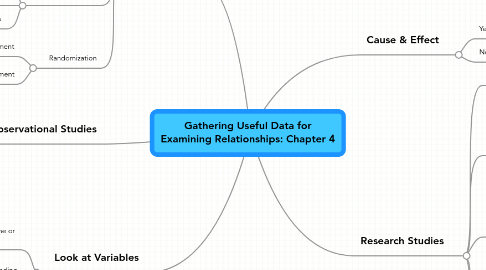
1. Experiment
1.1. Control Groups
1.2. Placebo
1.3. Blinding
1.3.1. Double Blinding
1.3.2. Single Blinding
1.4. Double Dummy
1.5. Pairing & Blocking
1.5.1. Matched Pair Designs
1.5.2. Block Design
1.5.3. Repeated Measure Designs
1.6. Randomization
1.6.1. Randomizing type of treatment
1.6.1.1. Chances of being assigned same for each participant
1.6.2. Randomizing order of treatment
2. Look at Variables
2.1. Response (aka, outcome or dependent)
2.1.1. Categorical data
2.1.2. Quantitative data
2.2. Confounding
2.2.1. Lurking
2.3. Explanatory
2.3.1. Independent
3. Observational Studies
3.1. Case Control
3.1.1. Efficient
3.1.2. Reduces confounding variables
3.2. Retrospective (looking back)
3.3. Prospective (looking forward)
3.4. Confounding variables
3.4.1. Less likely to be problem for randomized experiment
3.4.2. Lurking Variable
3.4.3. Related to explanatory variable
4. Cause & Effect
4.1. Yes
4.2. No
5. Research Studies
5.1. Observational
5.1.1. Observe or Question
5.1.2. Weaker cause & effect relationship
5.2. Experimental
5.2.1. Manipulate
5.2.2. Randomization is a crucial element
5.2.3. Volunteers
5.2.4. Stronger cause & effect relationship
5.3. Study Units
5.3.1. Subjects
5.3.2. Participants
5.3.3. People
5.4. Difficulties and Disasters
5.4.1. Confounding Variables
5.4.2. Extending results inappropriately
5.4.3. Interacting variables
5.4.4. Hawthorne and experimenter effects
5.4.5. Ecological validity and generalizability
5.4.6. Using the past as a source of data
